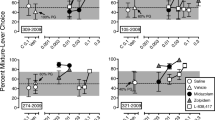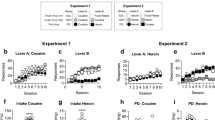Abstract
Rationale
Concurrent abuse of cocaine and heroin is a common form of polydrug abuse, but the interactions between the reinforcing effects of cocaine and heroin are poorly understood. Dose-addition analysis is a tool for the quantitative assessment of drug interactions, but this analysis has not been applied to evaluation of the reinforcing effects of cocaine and heroin.
Objectives
To evaluate interactions between the reinforcing effects of cocaine and heroin using dose-addition analysis.
Methods
Rhesus monkeys were trained under a concurrent-choice schedule of food delivery (1 gm pellets) and drug injections (cocaine or heroin, 0–0.1 mg kg−1 injection−1). Full dose–effect curves were determined for cocaine alone and heroin alone. Subsequently, full dose–effect curves were determined for three fixed-proportion mixtures of cocaine and heroin (fixed proportions of 1:3.2, 1:1 and 3.2:1 cocaine/heroin). Dose-addition analysis was used to assess whether cocaine/heroin interactions were super-additive, additive, or sub-additive.
Results
Cocaine, heroin, and all cocaine/heroin mixtures maintained dose-dependent and monotonic increases in drug choice and dose-dependent decreases in response rates. Choice dose–effect curves for cocaine/heroin mixtures were shifted to the left of dose–effect curves for cocaine or heroin alone, and dose-addition analysis indicated that cocaine/heroin interactions on drug choice were sub-additive or additive. Cocaine/heroin interactions on response-rate measures were also sub-additive or additive.
Conclusions
These results confirm that mixtures of cocaine and heroin produce reinforcing effects in rhesus monkeys; however, cocaine/heroin interactions were only or sub-additive or additive. Thus, these results do not support the hypothesis that simultaneously delivered cocaine and heroin produces super-additive reinforcing effects.


Similar content being viewed by others
References
Aigner TG, Balster RL (1978) Choice behavior in rhesus monkeys: cocaine versus food. Science 201:534–535
Arnold JM, Roberts DC (1997) A critique of fixed and progressive ratio schedules used to examine the neural substrates of drug reinforcement. Pharmacol Biochem Behav 57:441–447
Bickel WK, DeGrandpre RJ, Higgins ST (1995) The behavioral economics of concurrent drug reinforcers: a review and reanalysis of drug self-administration research. Psychopharmacology (Berl) 118:250–259
Carroll ME (1993) The economic context of drug and non-drug reinforcers affects acquisition and maintenance of drug-reinforced behavior and withdrawal effects. Drug Alcohol Depend 33:201–210
Derlet RW, Tseng CC, Tharratt RS, Albertson TE (1992) The effect of morphine and naloxone on cocaine toxicity. Am J Med Sci 303:165–169
Duvauchelle CL, Sapoznik T, Kornetsky C (1998) The synergistic effects of combining cocaine and heroin (“speedball”) using a progressive-ratio schedule of drug reinforcement. Pharmacol Biochem Behav 61:297–302
Griffiths RR, Wurster RM, Brady JV (1975) Discrete-trial choice procedure: effects of naloxone and methadone on choice between food and heroin. Pharmacol Rev 27:357–365
Griffiths RR, Wurster RM, Brady JV (1981) Choice between food and heroin: effects of morphine, naloxone, and secobarbital. J Exp Anal Behav 35:335–351
Hemby SE, Smith JE, Dworkin SI (1996) The effects of eticlopride and naltrexone on responding maintained by food, cocaine, heroin and cocaine/heroin combinations in rats. J Pharmacol Exp Ther 277:1247–1258
Kauppila T, Mecke E, Pertovaara A (1992) Enhancement of morphine-induced analgesia and attenuation of morphine-induced side-effects by cocaine in rats. Pharmacol Toxicol 71:173–178
Leander JD, Lucot JB (1977) Toxic interactions of stimulants, narcotics and narcotic antagonists. Res Commun Chem Pathol Pharmacol 17:255–264
Leri F, Bruneau J, Stewart J (2003) Understanding polydrug use: review of heroin and cocaine co-use. Addiction 98:7–22
Mattox AJ, Thompson SS, Carroll ME (1997) Smoked heroin and cocaine base (speedball) combinations in rhesus monkeys. Exp Clin Psychopharmacol 5:113–118
Mello NK, Negus SS, Lukas SE, Mendelson JH, Sholar JW, Drieze J (1995) A primate model of polydrug abuse: cocaine and heroin combinations. J Pharmacol Exp Ther 274:1325–1337
Nader MA, Woolverton WL (1991) Effects of increasing the magnitude of an alternative reinforcer on drug choice in a discrete-trials choice procedure. Psychopharmacology, 105:169–174
Negus SS (2003) Rapid assessment of choice between cocaine and food in rhesus monkeys: effects of environmental manipulations and treatment with d-amphetamine and flupenthixol. Neuropsychopharmacology 28:919–931
Negus SS (2004) Effects of the kappa opioid agonist U50,488 and the kappa opioid antagonist nor-binaltorphimine on choice between cocaine and food in rhesus monkeys. Psychopharmacology 176:204–213
Negus SS, Mello NK (2004) Effects of chronic methadone treatment on cocaine- and food-maintained responding under second-order, progressive-ratio and concurrent-choice schedules in rhesus monkeys. Drug Alcohol Depend 74:297–309
Negus SS, Mello NK, Lukas SE, Mendelson JH (1995) Diurnal patterns of cocaine and heroin self-administration in rhesus monkeys responding under a schedule of multiple daily sessions. Behav Pharmacol 6:763–775
Ranaldi R, Munn E (1998) Polydrug self-administration in rats: cocaine–heroin is more rewarding than cocaine-alone. NeuroReport 9:2463–2466
Rowlett JK, Woolverton WL (1997) Self-administration of cocaine and heroin combinations by rhesus monkeys responding under a progressive-ratio schedule. Psychopharmacology (Berl) 133:363–371
Schütz CG, Vlahov D, Anthony JC, Graham NMH (1994) Comparison of self-reported injection frequencies for past 30 days and 6 months among intravenous drug users. J Clin Epidemiol 47:191–195
Stafford D, LeSage MG, Glowa JR (1998) Progressive-ratio schedules of drug delivery in the analysis of drug self-administration: a review. Psychopharmacology 139:169–184
Stevenson GA, Linsenmayer DC, Folk JE, Rice KC, Negus SS (2003) Opioid interactions in rhesus monkeys: effects of delta+mu and delta+kappa agonists on schedule-controlled responding and thermal nociception. J Pharmacol Exp Ther 307:1054–1064
Tallarida RJ (2000) Drug synergism and dose–effect data analysis. Chapman & Hall/CRC, Boca Raton, FL
Walsh SL, Sullivan JT, Preston KL, Garner J (1996) The effects of naltrexone on response to i.v. cocaine, hydromorphone and their combination in humans. J Pharmacol Exp Ther 279:524–538
Wang NS, Brown VL, Grabowski J, Meisch RA (2001) Reinforcement by orally delivered methadone, cocaine, and methadone–cocaine combinations in rhesus monkeys: are the combinations better reinforcers? Psychopharmacology (Berl) 156:63–72
Wessinger WD (1986) Approaches to the study of drug interactions in behavioral pharmacology. Neurosci Biobehav Rev 10:103–113
Winger G, Skjoldager P, Woods JH (1992) Effects of buprenorphine and other opioid agonists and antagonists on alfentanil- and cocaine-reinforced responding in rhesus monkeys. J Pharmacol Exp Ther 261:311–317
Woolverton WL (1987) Analysis of drug interactions in behavioral pharmacology. In: Thompson T, Dews PB, Barrett JE (eds) Neurobehavioral pharmacology. Lawrence Erlbaum Associates, Hillsdale, NJ, 275–302
Woolverton WL, Balster RL (1979) The effects of lithium on choice between cocaine and food in the rhesus monkey. Commun Psychopharmacol 3:309–318
Acknowledgements
This work was supported by Grant RO1-DA02519 and P01-DA14528 from the National Institute on Drug Abuse, NIH. The author thanks Dr. Nancy K. Mello for comments on an earlier version of the manuscript and Sam McWilliams and Melissa Timm for expert technical assistance.
Author information
Authors and Affiliations
Corresponding author
Rights and permissions
About this article
Cite this article
Negus, S.S. Interactions between the reinforcing effects of cocaine and heroin in a drug-vs-food choice procedure in rhesus monkeys: a dose-addition analysis. Psychopharmacology 180, 115–124 (2005). https://doi.org/10.1007/s00213-004-2133-y
Received:
Accepted:
Published:
Issue Date:
DOI: https://doi.org/10.1007/s00213-004-2133-y




